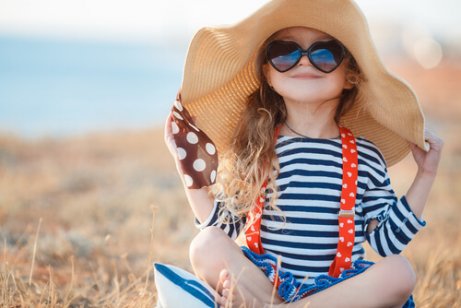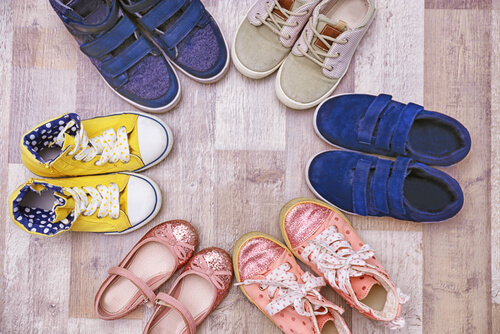How to Choose Your Children's Clothes

Picking out your children’s clothes can sometimes be a complicated task. This is especially true for first-time parents. We want our children to feel comfortable and be free to roll around on the floor and get dirty. But at the same time, we also love it when they are neat and tidy.
Even during adolescence, the function that shoes and clothing fulfill shouldn’t be based solely on keeping up appearances. That doesn’t mean we can’t make an effort to keep our children looking good or that we should promote sloppiness. But we should allow our children to have a say in what they wear.
As parents, we need to realize that, when it comes to children, we need to make comfort and functionality priority. It makes no sense to try to maintain a spotless image if it means your child can’t have fun and be a kid.
In this sense, many of us are guilty of putting our own vanity before the needs of our little ones as children.
How to choose your children’s clothes
Ergonomic function
Ergonomic function focuses on providing children with the ability to move around freely. It’s important that your children’s clothing be easy to put on, stretchy, and have rubber fasteners. You should stay away from tight fitting belts, which can injure your little one.
Below are a few “golden rules” for building anyone’s wardrobe – including that of small children:
- Comfort, above all else. Get rid of any items that don’t fit your little one or that make him or her uncomfortable. If it’s too small, pass it on to someone else. If it’s too big, wait until your child grows into it.
- Avoid fabrics that aren’t breathable. Fabrics like imitation leather, tulle, and other synthetic fibers won’t allow your child’s skin to breathe.
- Try to maintain a balance between everyday clothing and clothes for special occasions. This will make it easier for you to combine both. And, when your child is able to dress him or herself, this will make it much easier.

- When it comes to footwear, it’s extremely important that your child’s shoes adapt to his or her feet. Why is this? Adequate footwear keeps your child’s feet from becoming deformed and help your little one to walk properly.
- Make sure the clothing you choose is appropriate for your geographic region! This is very important. We need to keep in mind that our kids can’t wear summer clothes all year round when we live in a 4-season region. If you live in a very dry or humid area, then you need to take that into account when dressing your children.
- Don’t go overboard with accessories. Not only can they be uncomfortable, but they can also break easily and even be hazardous. It’s important to use caution and common sense when choosing what accessories you put on your child.
The “right” colors
Despite social conventionalism, there are no “right” colors for boys or girls. Parents are free to dress their children in any color they choose, because the colors a child wears are not what defines his or her gender.
Your son can like the color pink, and your daughter can like the color blue. Or they can like purple, or green, or yellow. And that’s okay! Clothing is a good way to educate children beyond the ancient norms that society often tries to impose.
The key when it comes to choosing clothing colors is being creative and not imposing limits. There are many ways to combine different colors. The result will depend on how well you know how to play with them when choosing your child’s outfit.
And let’s not forget the benefits of color therapy. Dressing your little ones in certain colors can boost their creativity, improve mood and make them more active.
Seasonal clothes and shoes
Children should wear clothing and footwear that fits the time of year. If the weather is hot, then you should never put your child in heavy clothing or stifling shoes. And in the same way, you shouldn’t force your child to wear thin fabrics or short dresses if the temperature is too low.
Dressing properly according to weather conditions isn’t just a question of comfort, but also a question of health. Inappropriate clothing can cause your child to get a cold, to overheat. And of course, it can also put your little one in a bad mood.
In colder weather, make sure your child is wearing closed toed shoes. On warm, sunny days, reach for sandals, flip flops, or canvas tennis shoes.

It’s important to put our child’s health and happiness first, not the image we want to portray. When choosing the clothes your child will wear, we shouldn’t project our own tastes and desires on them. Rather, we should let the clothing be a reflection of who they are.
Choosing clothes for your baby
When it comes to babies, the guidelines are much more specific. There are several factors and details that you need to pay attention to when picking out your baby’s clothing.
When babies are under 12 months of age, then it’s especially important to avoid clothing with large straps or ties. This is because they can get caught or snag on other objects.
Snaps and velcro closures need to be easy to open and close and shouldn’t rub or pinch your baby’s delicate skin. Also, make sure all snaps and decals, etc., are securely attached to the clothing to avoid a choking hazard. It’s best to stay away from clothing with buttons and zippers.
Small babies should only use socks or booties. Putting tiny shoes on your newborn may be a temptation, but remember there really is no need. Whatever you put on your little one’s feet should be flexible and well fitting. As for crawlers and walkers, you can opt for socks or soft soled shoes with rubber gripping to avoid accidents.
Sweaters and jackets should be loose fitting so that your child can move freely. Avoid articles that have to go over your little one’s head, unless the neck is wide enough to go on and off without a struggle. Babies can become anxious when an article of clothing remains over their face for too long.
Can my children pick out their own clothing?
The answer is yes. However, it depends on two factors: Age and personality. Children can begin choosing their own clothing when they’re able to reason and can distinguish between colors, fabrics, and their own tastes.
When it comes to choosing clothing for your children, you should always listen to what they themselves have to say about it.
If a disagreement arises, avoid getting into an argument. It’s better to explain why certain clothes or shoes aren’t appropriate for the occasion. That way, you’ll be helping your little ones use logic and develop criteria. Of course, avoid rigidity and allow for flexibility when appropriate.
When you give your children the opportunity to express their tastes and choose their clothing, this boosts autonomy. It also contributes to the formation of their personality.
If you deny your child the option of having a say, you limit creativity and damage self-esteem. When you take your little one’s opinion into consideration, you create a sense of responsibility and show respect.
Children have an infinite supply of ideas. If we allow them to develop their creativity and imagination at a young age, then they won’t be afraid of controversy in the future.
As parents, we always want what’s best for our family and we want to protect them from ridicule. However, listening to our kids can often open our minds and dispel many of our prejudices.
Remember that, while there are basic rules regarding what clothing is appropriate at one time or another, we should still allow for fun and creativity.
Picking out your children’s clothes can sometimes be a complicated task. This is especially true for first-time parents. We want our children to feel comfortable and be free to roll around on the floor and get dirty. But at the same time, we also love it when they are neat and tidy.
Even during adolescence, the function that shoes and clothing fulfill shouldn’t be based solely on keeping up appearances. That doesn’t mean we can’t make an effort to keep our children looking good or that we should promote sloppiness. But we should allow our children to have a say in what they wear.
As parents, we need to realize that, when it comes to children, we need to make comfort and functionality priority. It makes no sense to try to maintain a spotless image if it means your child can’t have fun and be a kid.
In this sense, many of us are guilty of putting our own vanity before the needs of our little ones as children.
How to choose your children’s clothes
Ergonomic function
Ergonomic function focuses on providing children with the ability to move around freely. It’s important that your children’s clothing be easy to put on, stretchy, and have rubber fasteners. You should stay away from tight fitting belts, which can injure your little one.
Below are a few “golden rules” for building anyone’s wardrobe – including that of small children:
- Comfort, above all else. Get rid of any items that don’t fit your little one or that make him or her uncomfortable. If it’s too small, pass it on to someone else. If it’s too big, wait until your child grows into it.
- Avoid fabrics that aren’t breathable. Fabrics like imitation leather, tulle, and other synthetic fibers won’t allow your child’s skin to breathe.
- Try to maintain a balance between everyday clothing and clothes for special occasions. This will make it easier for you to combine both. And, when your child is able to dress him or herself, this will make it much easier.

- When it comes to footwear, it’s extremely important that your child’s shoes adapt to his or her feet. Why is this? Adequate footwear keeps your child’s feet from becoming deformed and help your little one to walk properly.
- Make sure the clothing you choose is appropriate for your geographic region! This is very important. We need to keep in mind that our kids can’t wear summer clothes all year round when we live in a 4-season region. If you live in a very dry or humid area, then you need to take that into account when dressing your children.
- Don’t go overboard with accessories. Not only can they be uncomfortable, but they can also break easily and even be hazardous. It’s important to use caution and common sense when choosing what accessories you put on your child.
The “right” colors
Despite social conventionalism, there are no “right” colors for boys or girls. Parents are free to dress their children in any color they choose, because the colors a child wears are not what defines his or her gender.
Your son can like the color pink, and your daughter can like the color blue. Or they can like purple, or green, or yellow. And that’s okay! Clothing is a good way to educate children beyond the ancient norms that society often tries to impose.
The key when it comes to choosing clothing colors is being creative and not imposing limits. There are many ways to combine different colors. The result will depend on how well you know how to play with them when choosing your child’s outfit.
And let’s not forget the benefits of color therapy. Dressing your little ones in certain colors can boost their creativity, improve mood and make them more active.
Seasonal clothes and shoes
Children should wear clothing and footwear that fits the time of year. If the weather is hot, then you should never put your child in heavy clothing or stifling shoes. And in the same way, you shouldn’t force your child to wear thin fabrics or short dresses if the temperature is too low.
Dressing properly according to weather conditions isn’t just a question of comfort, but also a question of health. Inappropriate clothing can cause your child to get a cold, to overheat. And of course, it can also put your little one in a bad mood.
In colder weather, make sure your child is wearing closed toed shoes. On warm, sunny days, reach for sandals, flip flops, or canvas tennis shoes.

It’s important to put our child’s health and happiness first, not the image we want to portray. When choosing the clothes your child will wear, we shouldn’t project our own tastes and desires on them. Rather, we should let the clothing be a reflection of who they are.
Choosing clothes for your baby
When it comes to babies, the guidelines are much more specific. There are several factors and details that you need to pay attention to when picking out your baby’s clothing.
When babies are under 12 months of age, then it’s especially important to avoid clothing with large straps or ties. This is because they can get caught or snag on other objects.
Snaps and velcro closures need to be easy to open and close and shouldn’t rub or pinch your baby’s delicate skin. Also, make sure all snaps and decals, etc., are securely attached to the clothing to avoid a choking hazard. It’s best to stay away from clothing with buttons and zippers.
Small babies should only use socks or booties. Putting tiny shoes on your newborn may be a temptation, but remember there really is no need. Whatever you put on your little one’s feet should be flexible and well fitting. As for crawlers and walkers, you can opt for socks or soft soled shoes with rubber gripping to avoid accidents.
Sweaters and jackets should be loose fitting so that your child can move freely. Avoid articles that have to go over your little one’s head, unless the neck is wide enough to go on and off without a struggle. Babies can become anxious when an article of clothing remains over their face for too long.
Can my children pick out their own clothing?
The answer is yes. However, it depends on two factors: Age and personality. Children can begin choosing their own clothing when they’re able to reason and can distinguish between colors, fabrics, and their own tastes.
When it comes to choosing clothing for your children, you should always listen to what they themselves have to say about it.
If a disagreement arises, avoid getting into an argument. It’s better to explain why certain clothes or shoes aren’t appropriate for the occasion. That way, you’ll be helping your little ones use logic and develop criteria. Of course, avoid rigidity and allow for flexibility when appropriate.
When you give your children the opportunity to express their tastes and choose their clothing, this boosts autonomy. It also contributes to the formation of their personality.
If you deny your child the option of having a say, you limit creativity and damage self-esteem. When you take your little one’s opinion into consideration, you create a sense of responsibility and show respect.
Children have an infinite supply of ideas. If we allow them to develop their creativity and imagination at a young age, then they won’t be afraid of controversy in the future.
As parents, we always want what’s best for our family and we want to protect them from ridicule. However, listening to our kids can often open our minds and dispel many of our prejudices.
Remember that, while there are basic rules regarding what clothing is appropriate at one time or another, we should still allow for fun and creativity.
This text is provided for informational purposes only and does not replace consultation with a professional. If in doubt, consult your specialist.








